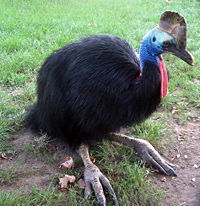
Photo from wikipedia
Melanin is a common pigment that can indicate individual quality to potential mates and social dominance to competitors. For many avian species, plumage melanism varies within both males and females.… Click to show full abstract
Melanin is a common pigment that can indicate individual quality to potential mates and social dominance to competitors. For many avian species, plumage melanism varies within both males and females. If predictive of individual quality, sexual selection may drive contrasting expressions of melanism for each sex, reflecting their different reproductive roles. For an alpine population of horned larks, Eremophila alpestris, we investigated whether plumage ornament size and darkness predicted morphometric traits, parental care and fitness correlates, and we evaluated support for assortative pairing. Males with darker crowns and larger masks were associated with greater wing length and mass, respectively. Males with darker ornaments were paired with females that provisioned nestlings at a higher rate, began nesting earlier in the season, had larger clutch sizes and ultimately had greater nest success. For females, plumage ornaments did not predict morphometric traits (i.e. wing length, mass), provisioning rate of the male partner, clutch initiation date or reproductive success. Instead, females with darker crowns provisioned nestlings more frequently and had larger clutches. Overall darker males tended to pair with darker females, but plumage ornament size did not correlate within mated pairs. We demonstrate that: (1) the darkness of plumage ornaments is a better predictor of fitness than ornament size and (2) darker males are associated with greater individual quality and reproductive investment of the female mate, while female darkness primarily predicts reproductive investment. These results indicate the potential for sex-specific selection pressures and mate choice based on the predictive value of plumage melanism.
Journal Title: Animal Behaviour
Year Published: 2019
Link to full text (if available)
Share on Social Media: Sign Up to like & get
recommendations!